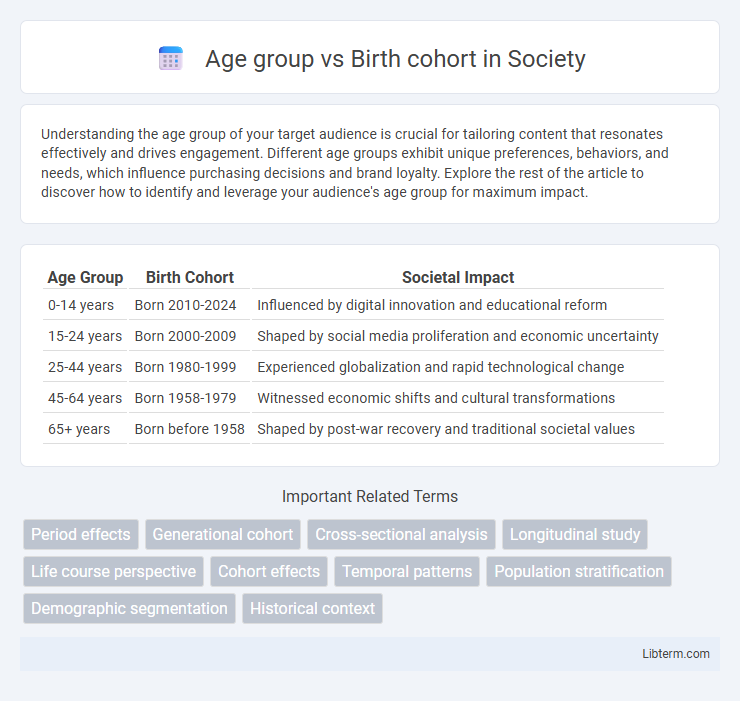Understanding the age group of your target audience is crucial for tailoring content that resonates effectively and drives engagement. Different age groups exhibit unique preferences, behaviors, and needs, which influence purchasing decisions and brand loyalty. Explore the rest of the article to discover how to identify and leverage your audience's age group for maximum impact.
Table of Comparison
| Age Group | Birth Cohort | Societal Impact |
|---|---|---|
| 0-14 years | Born 2010-2024 | Influenced by digital innovation and educational reform |
| 15-24 years | Born 2000-2009 | Shaped by social media proliferation and economic uncertainty |
| 25-44 years | Born 1980-1999 | Experienced globalization and rapid technological change |
| 45-64 years | Born 1958-1979 | Witnessed economic shifts and cultural transformations |
| 65+ years | Born before 1958 | Shaped by post-war recovery and traditional societal values |
Defining Age Groups and Birth Cohorts
Age groups classify individuals based on their current age ranges, such as 18-24 or 65-74, facilitating demographic analysis and targeted policy development. Birth cohorts refer to groups of individuals born during the same time period, often a single year or range of years, providing insight into generational experiences and historical influences. Defining age groups captures cross-sectional snapshots of populations, while birth cohorts track longitudinal changes and social trends across time.
Key Differences Between Age Groups and Birth Cohorts
Age groups classify individuals based on their current age range, such as 18-24 or 65+, providing a snapshot of demographics within a specific time frame. Birth cohorts consist of people born during the same period, for example, the Baby Boomers (1946-1964) or Millennials (1981-1996), highlighting shared experiences and historical influences shaping their behaviors. The key difference lies in age groups reflecting temporal stages of life, while birth cohorts emphasize generational identity and longitudinal socio-cultural impacts.
Historical Context: Why Birth Cohorts Matter
Birth cohorts signify groups of individuals born during the same period, capturing the unique social, economic, and environmental influences experienced throughout their lives. Tracking birth cohorts allows researchers to analyze how historical events and cultural shifts impact long-term health, behavior, and socioeconomic outcomes differently than age groups alone. Understanding these cohort effects is crucial for accurately assessing generational changes and predicting future trends influenced by specific historical contexts.
Societal Trends Influenced by Age Groups
Age groups, defined by current age ranges, influence societal trends such as consumer behavior, technological adoption, and workforce participation, while birth cohorts represent individuals born in the same period sharing historical experiences that shape cultural values and political attitudes. Societal trends often reflect the interplay between age group dynamics and cohort-specific influences, evident in generational shifts like the Millennial embrace of digital technology or Baby Boomer retirement patterns. Understanding these distinctions helps policymakers and marketers anticipate changes in demographics, economic demands, and social preferences.
Research Methods: Studying Age vs. Cohort Effects
Research methods distinguishing age group versus birth cohort effects emphasize the importance of separating developmental changes from generational influences. Age group analysis examines variations among individuals at specific ages, while birth cohort studies track groups born in the same period to identify historical and social impacts on behavior or health. Longitudinal designs and cross-sequential approaches are crucial for isolating age-related changes from cohort-specific characteristics in social and epidemiological research.
Implications in Health and Epidemiology
Age group classifications provide a snapshot of health outcomes at specific life stages, while birth cohorts track populations born in the same period, revealing long-term epidemiological trends influenced by environmental, social, and medical changes. Cohort analysis enables identification of generational risk factors for diseases such as cardiovascular conditions or cancers, which may be masked when only age groups are considered. Understanding the differences between age group and birth cohort data improves the accuracy of public health interventions and the prediction of future healthcare needs.
Age Group vs. Birth Cohort in Social Science Studies
Age group and birth cohort are distinct concepts in social science studies used to analyze population dynamics and social behavior over time. Age group refers to individuals classified by their current age range, while birth cohort tracks people born in the same period, allowing researchers to study generational effects and historical context. Understanding the difference enhances the interpretation of longitudinal data and helps identify age-related versus cohort-specific social trends.
Challenges in Distinguishing Age and Cohort Effects
Distinguishing age group effects from birth cohort effects presents significant challenges due to their intrinsic interdependence, as individuals' experiences are simultaneously influenced by their chronological age and the historical context of their birth cohort. Statistical models often struggle to disentangle these effects because age, period, and cohort variables are linearly dependent, leading to identification problems that complicate causal inference. Careful longitudinal data analysis and advanced modeling techniques are essential to accurately isolate how aging processes and cohort-specific social, economic, or environmental factors independently affect health, behavior, or social outcomes.
Practical Applications in Policy and Marketing
Analyzing age groups versus birth cohorts enables policymakers to tailor social programs and healthcare services by identifying generational needs and behavioral trends. Marketers leverage birth cohort data to develop targeted advertising campaigns that resonate with specific consumer experiences shaped by historical events. This segmentation improves strategic decision-making in resource allocation and customer engagement by capturing the dynamic lifecycle and cultural context of populations.
Conclusion: Choosing the Right Framework for Analysis
Selecting the appropriate framework between age group and birth cohort analysis depends on the research objective and data interpretation needs. Age group analysis offers insights into behaviors or trends across different life stages at a specific time, while birth cohort analysis traces patterns and changes experienced by individuals born in the same period over time. For longitudinal studies that examine generational effects and temporal shifts, birth cohort frameworks provide more precise understanding, whereas age group analysis better suits cross-sectional snapshots.
Age group Infographic

 libterm.com
libterm.com